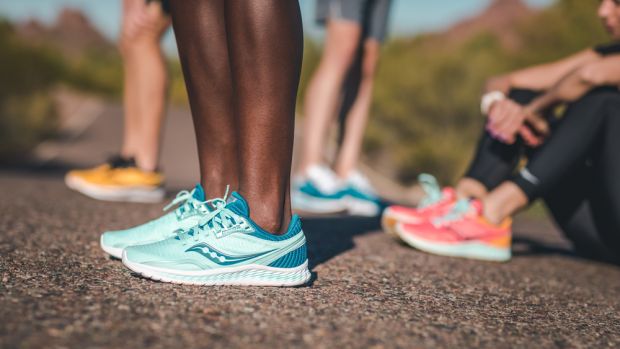You can trust Coach
When a shoe reaches its 11th edition, it’s a good sign that it’s doing something right. The Kinvara has been immensely popular since its launch over a decade ago, with its lightweight, cushioned ride and 4mm heel-to-toe offset appealing to runners seeking a low-drop trainer that can handle a variety of runs.
This is the third edition of the Kinvara that I’ve run in, having used and enjoyed running in the 8 and 10. With a new midsole material thrown into the mix for the 11 – Saucony’s bouncy and lightweight PWRRUN, which was the highlight of the Triumph 17 – I was excited about trying it.
That excitement only grew when I saw the shoe, because the blue colourway might be my favourite running shoe design ever. I know that’s a matter of taste and irrelevant to how it runs, but it’s fair to say I was rooting for the 11 to be a brilliant shoe on the basis that I wanted it in my rotation for its looks.
Fortunately the Kinvara 11 backed up its appearances with a top-quality ride. The last edition, the Kinvara 10, stood out for me by offering an incredibly smooth transition from heel to toe. That’s not the case with the 11: it has a bit more bounce instead, and also feels a little softer.

Bouncier and softer are good things in my book, but I’d also say the Kinvara 11 has moved the shoe more firmly into the training arena, whereas past Kinvaras have been all-rounders well-suited to racing, especially over long distances. The 11 is no slouch and still light at 233g (men’s), and it would make for a comfortable and quickish marathon shoe, but I found picking up the pace easier in the 10.
It’s a more enjoyable shoe to use for easy training, though, and still great for tempo and harder long runs too. The padded tongue and collar, plus the stretchy upper all combine with the underfoot cushioning to create a shoe that’s comfortable from top to bottom.
This all makes the Kinvara 11 a lightweight and comfortable daily trainer, but there is increased competition in that area from shoes that are also better for fast running. Chief among these is the Nike Pegasus Turbo 2, which is also soft and bouncy but feels quicker too. Admittedly the Turbo 2 is expensive at £159.95, compared with £115 for the Kinvara 11, but there’s also the Hoka One One Rincon at £105, which is another excellent shoe that’s lightweight, cushioned and fast. The Rincon also has a low heel-to-toe drop – 5mm, similar to the 4mm of the Kinvara – and I’d certainly lean towards the Hoka if I was picking between the two shoes as a versatile trainer.
Sign up for workout ideas, training advice, reviews of the latest gear and more.
If you’ve loved the Kinvara in the past, the new edition does tweak the formula to be more of a trainer than a trainer-racer but it’s not so drastically different that I’d recommend steering clear – it’s still a great shoe to pull on day to day. If you’ve no experience of this line, however, I’d say the Hoka Rincon offers a faster ride while still being comfortable to use for easy runs.

Nick Harris-Fry is a journalist who has been covering health and fitness since 2015. Nick is an avid runner, covering 70-110km a week, which gives him ample opportunity to test a wide range of running shoes and running gear. He is also the chief tester for fitness trackers and running watches, treadmills and exercise bikes, and workout headphones.

